Zigbee Security vulnerability that affected Hue Smart bulbs has been patched

What you need to know
- A security vulnerability found in some smart bulbs could have given hackers access to the local host network it was connected to.
- The flaw relates to the Zigbee communication protocol, used by devices such as Philips Hue bulbs.
- Check Point found that a 2017 vulnerability could in fact be used to launch attacks on a conventional computer network, thankfully it's now been fixed.
A security flaw in the Zigbee communication protocol used by Smart bulbs could have been used to launch attacks on conventional computer networks in homes and businesses. Thankfully, it's now been fixed.
According to Check Point, they explored whether a vulnerability found in 2017 could, in fact, be used to gain access to the host network that the device was connected too. The answer? Yes. The issue has now been patched, so checking your firmware would be a very good idea.
The report notes:
Continuing from where the previous research left off, Check Point's researchers showed how a threat actor could exploit an IoT network (smart lightbulbs and their control bridge) to launch attacks on conventional computer networks in homes, businesses or even smart cities. Our researchers focused on the market-leading Philips Hue smart bulbs and bridge, and found vulnerabilities (CVE-2020-6007) that enabled them to infiltrate networks using a remote exploit in the ZigBee low-power wireless protocol that is used to control a wide range of IoT devices. With the help of the Check Point Institute for Information Security (CPIIS) in Tel Aviv University, the researchers were able to take control of a Hue lightbulb on a target network and install malicious firmware on it. From that point, they used the lightbulb as a platform to take over the bulbs' control bridge, and attacked the target network as follows:
- The hacker controls the bulb's color or brightness to trick users into thinking the bulb has a glitch. The bulb appears as 'Unreachable' in the user's control app, so they will try to 'reset' it.
- The only way to reset the bulb is to delete it from the app, and then instruct the control bridge to re-discover the bulb.
- The bridge discovers the compromised bulb, and the user adds it back onto their network.
- The hacker-controlled bulb with updated firmware then uses the ZigBee protocol vulnerabilities to trigger a heap-based buffer overflow on the control bridge, by sending a large amount of data to it. This data also enables the hacker to install malware on the bridge – which is in turn connected to the target business or home network.
- The malware connects back to the hacker and using a known exploit (such as EternalBlue), they can infiltrate the target IP network from the bridge to spread ransomware or spyware.
If that didn't make sense, here's' a video:
Check Point told Philips and Signify (Philips Hue's parent company) about the vulnerability in November 2019. A recent firmware patch [Firmware 1935144040] is now available on their site and was issued as an automatic update, so you just need to double-check your firmware.
Check Point plans to release the full technical details of its research in the coming weeks, once everyone has had time to safely update their products.
Be an expert in 5 minutes
Get the latest news from Android Central, your trusted companion in the world of Android

